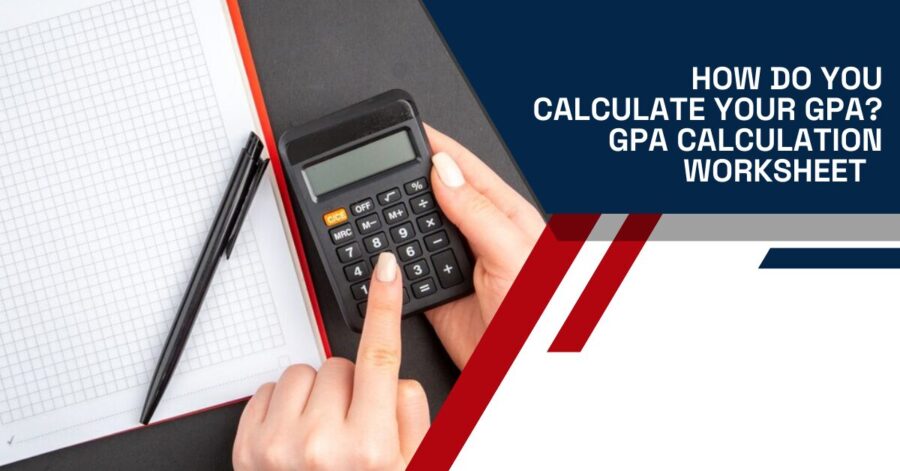16 December 2024
6 minutes read
How do you calculate your GPA? GPA Calculation Worksheet

Key Takeaways
- GPA is a crucial measure of academic performance, influencing college admissions, scholarships, and career opportunities.
- Understand the differences between cumulative, semester, weighted, and unweighted GPAs to gauge academic standing.
- Calculate GPA by converting grades into numerical values, factoring in course credits, and using a consistent scale.
Have you ever wondered how your academic performance is measured and compared? Understanding GPA, or Grade Point Average, is essential for students aiming for academic success. This blog explores the significance of GPA, the different types and scales used, and provides a step-by-step guide on how to calculate it.
Whether you’re planning for college admissions, scholarships, or career opportunities, knowing how to manage and improve your average GPA can make a significant difference in your educational journey.
What is GPA?
GPA, or Grade Point Average, is a standardized measure of academic achievement in educational institutions. It represents the average of a student’s grades, typically on a scale from 0 to 4.0, though other scales exist.
GPA is calculated by assigning numerical values to letter grades and averaging these values based on the credits of each course. It is used to assess a student’s academic performance, eligibility for scholarships, admissions to higher education institutions, and sometimes employment opportunities. GPA reflects both the quality and quantity of work a student has completed.
Why is GPA important?
GPA, or Grade Point Average, plays a crucial role in various aspects of academic and professional life. It serves as a standardized measure of a student’s academic performance and is instrumental in shaping educational and career opportunities. Here’s why GPA is important:
- Academic Evaluation: GPA is used to evaluate students’ academic performance, helping educators identify areas of strength and weakness.
- College Admissions: College GPA matters as they use it as a key criterion for admissions, often setting minimum GPA requirements.
- Scholarships and Financial Aid: Many scholarships and financial aid programs consider GPA as a primary factor in awarding funds.
- Career Opportunities: Employers may review GPA as part of the hiring process, especially for recent graduates.
Components of GPA Calculation
The components of GPA calculation include:
- Course Credits: Each course is assigned a specific number of credits or credit hours, reflecting its weight in the overall curriculum. More intensive courses usually carry more credits.
- Grades: Students receive grades for their performance in each course, typically in the form of letters (A, B, C, etc.), which are then converted into numerical grade points.
- Grade Points: Each letter grade corresponds to a numerical value on the GPA scale (e.g., A = 4.0, B = 3.0). The value assigned to each grade may vary depending on the scale used by the institution.
- Quality Points: Quality points are calculated by multiplying the grade points by the number of credits for each course. This reflects the weight of the course in the overall GPA.
- Total Credits and Total Quality Points: The sum of all course credits and quality points are used in the cumulative GPA calculation. The total quality points are divided by the total credits to determine the GPA.
These components collectively provide a standardized metric for evaluating academic performance.
Most commonly employed GPA scales
The most commonly employed GPA scales include:
- 4.0 Scale: Widely used in the United States, this scale ranges from 0.0 to 4.0, with 4.0 typically representing an ‘A’ grade. It often includes distinctions for plus and minus grades, such as A- (3.7) or B+ (3.3).
- 5.0 Scale: Often utilized in high schools for honours or Advanced Placement (AP) courses, this scale can assign a maximum GPA of 5.0 to reflect the increased difficulty of these courses.
- 10.0 Scale: Common in India and other countries, students use a college GPA calculator on a 10 point scale for more precise differentiation in academic performance. This scale ranges from 0 to 10
- 7.0 Scale: Used in certain international educational systems, where a 7.0 represents the highest academic achievement. To calculate your GPA on a 7-point scale using a GPA calculator, input your course grades and their corresponding credit hours; the calculator will then compute the weighted average based on the 7-point grading system.

Here is a comparison of the GPA 4.0 scale and GPA 7.0 scale:
| GPA 4.0 Scale | Description | GPA 7.0 Scale | Description |
|---|---|---|---|
| 4.0 | A (Excellent) | 7.0 | High Distinction |
| 3.7 | A- | 6.0 | Distinction |
| 3.3 | B+ | 5.0 | Credit |
| 3.0 | B (Good) | 4.0 | Pass |
| 2.7 | B- | 3.0 | Marginal Pass |
| 2.3 | C+ | 2.0 | Fail |
| 2.0 | C (Average) | 1.0 | Fail |
| 1.7 | C- | 0.0 | Fail (Below acceptable performance) |
| 1.3 | D+ | ||
| 1.0 | D (Poor) | ||
| 0.0 | F (Failing) |
This table compares the numerical values and corresponding grade descriptions between the 4.0 and 7.0 GPA scales, highlighting how different systems evaluate academic performance.
Types of GPA
Understanding the various types of GPA is crucial for students to effectively gauge their academic performance and plan their educational paths. Here are they,
Cumulative GPA
It is an overall measure of a student’s academic performance throughout their academic career. You can calculate your cumulative GPA by averaging the grade points earned in all courses taken, factoring in the credits for each course. This GPA is crucial for assessing long-term academic success and eligibility for honours, scholarships, and graduation.
Semester GPA
Semester GPA represents the average grade points earned in a specific semester. It helps students understand their academic performance in a given term, allowing them to enter subsequent terms with insights into areas that may need improvement.
Weighted GPA
Weighted GPA accounts for the difficulty of the courses taken, assigning higher point values to advanced or honours courses. This GPA gives a more accurate reflection of a student’s academic effort and capabilities, having a positive effect on their academic profile.
Unweighted GPA
Unweighted GPA treats all courses equally, without considering their difficulty. It provides a straightforward average of all grades, commonly used for general academic evaluations.
How to calculate GPA using a calculator?
Calculating GPA using a calculator involves a few straightforward steps. Here’s a step-by-step guide:
Step 1: Gather Necessary Information
Collect the following details for each course:
- Credits: The number of credit hours assigned to the course.
- Grades: The letter grade received in the course.
Step 2: Assign Grade Points
Convert each letter grade into a numerical value based on your GPA scale. For example, on a 4.0 scale:
- A = 4.0
- B = 3.0
- C = 2.0
- D = 1.0
- F = 0.0
Step 3: Calculate Quality Points
For each course, multiply the grade points by the number of credits to get the quality points.
Quality Points=Grade Points × Credits
Step 4: Sum Up Quality Points and Credits
Add up the total quality points and the total number of credits for all courses.
Step 5: Calculate GPA
Divide the total quality points by the total number of credits.
GPA= Total Quality Points / Total Credits
GPA Calculation Worksheet

Here’s an example GPA calculation worksheet to help illustrate the process:
| Course | Credits | Grade | Grade Points | Quality Points |
|---|---|---|---|---|
| Math | 4 | A | 4.0 | 4.0 * 4 = 16.0 |
| English | 3 | B+ | 3.3 | 3.3 * 3 = 9.9 |
| History | 3 | B | 3.0 | 3.0 * 3 = 9.0 |
| Science | 4 | C | 2.0 | 2.0 * 4 = 8.0 |
| Art | 2 | A- | 3.7 | 3.7 * 2 = 7.4 |
Total Calculation
- Total Credits: 4 (Math) + 3 (English) + 3 (History) + 4 (Science) + 2 (Art) = 16 credits
- Total Quality Points: 16.0 (Math) + 9.9 (English) + 9.0 (History) + 8.0 (Science) + 7.4 (Art) = 50.3 quality points
GPA Calculation
GPA= Total Quality Points / Total Credits
GPA= 50.3 / 16 = 3.14
How to improve your GPA?
Improving your GPA requires strategic effort and consistency. Here are some effective ways to boost your GPA:
- Attend All Classes: Regular attendance helps you understand the material better and stay on top of coursework.
- Develop Good Study Habits: Set a regular study schedule, review notes daily, and use effective study techniques.
- Seek Help When Needed: Utilize resources like tutoring centres, study groups, and office hours for extra assistance.
- Prioritize Coursework: Focus on assignments and projects that significantly impact your grade.
- Improve Time Management: Organize your time to balance studies, extracurricular activities, and rest.
- Take Care of Your Health: Maintain a healthy lifestyle, as good physical and mental health can improve academic performance.
Conclusion
Understanding GPA, its types, calculation methods, and GPA to CGPA calculator is crucial for academic success and future opportunities. By attending classes, developing good study habits, and managing time effectively, students can improve their GPA, which plays a significant role in college admissions, scholarships, and career prospects. This guide provides a comprehensive overview to help students navigate and enhance their academic performance.
Embark on a seamless journey to top universities with Ambitio Elite. Allow our AI Copilot and mentors to guide you to success. Enroll now and embark on your academic journey! Explore Ambitio Elite
FAQs
How do I calculate my cumulative GPA?
To calculate cumulative GPA, sum the quality points for all courses taken to date, then divide by the total number of credits earned. This provides an overall measure of academic performance throughout your education.
Can I retake a course to improve my GPA?
Many institutions allow students to retake courses to improve their GPA. The new grade often replaces the old one in GPA calculations, though policies vary by school.
Do extracurricular activities affect my GPA?
No, extracurricular activities do not affect GPA directly. However, they can be important for college admissions and scholarships alongside your academic record.
What is the impact of a failing grade on my GPA?
A failing grade (F) significantly lowers your GPA as it typically adds zero points to your total while still counting towards your total credits.
What is a good GPA for college admissions?
A GPA of 3.0 or higher is generally considered good, but competitive programs often require GPAs of 3.5 or above. Requirements vary by institution and program.
Can I calculate GPA if my school uses a different scale?
Yes, you can convert grades from other scales to a 4.0 scale by using conversion charts or online calculators. Each scale will have a corresponding set of points.

You can study at top universities worldwide!
Get expert tips and tricks to get into top universities with a free expert session.
Book Your Free 30-Minute Session Now! Book a call now




























